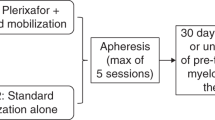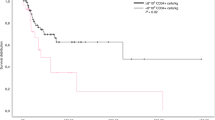Summary:
From 2000 to 2004, 152 patients with multiple myeloma aged ⩽65 years, enrolled in high-dose programs, were treated with two schedules of DCEP (dexamethasone, cyclophosphamide, etoposide, and cisplatin): 106 patients (group I) were mobilized with the infusional version of DCEP (infusional-DCEP), and 46 patients (group II) with a shorter version (DCEP-short). The median number of CD34+ cells collected was similar in the two groups as was the percentage of patients yielding ⩾4 × 106 cells/kg. The proportion of patients in whom mobilization failed was similar in the two groups. The incidence of WHO grade III neutropenia was higher in group II, although the difference was not statistically significant; the percentage of patients requiring hospitalization for severe infections was similar in the two groups. The incidence of WHO grade IV thrombocytopenia did not differ between the two groups. The response rate was 72% in group I and 80% in group II with similar percentages of patients achieving good responses. DCEP-short is a good mobilizing regimen, sharing the same characteristics as infusional-DCEP: high mobilizing efficacy, low toxicity and good antitumor activity. This new schedule of DCEP does, however, allow complete outpatient management and so could be advantageously included in any high-dose therapy program.
This is a preview of subscription content, access via your institution
Access options
Subscribe to this journal
Receive 12 print issues and online access
$259.00 per year
only $21.58 per issue
Buy this article
- Purchase on Springer Link
- Instant access to full article PDF
Prices may be subject to local taxes which are calculated during checkout
Similar content being viewed by others
References
Attal M, Harousseau JL, Stoppa AM et al. A prospective, randomized trial of autologous bone marrow transplantation and chemotherapy in multiple myeloma. Intergroup francais du Myelome. N Engl J Med 1996; 335: 91–97.
Child J, Morgan G, Davies F et al. High-dose chemotherapy with hematopoietic stem-cell rescue for multiple myeloma. N Engl J Med 2003; 348: 1875–1883.
Moreau P, Facon T, Attal M et al. Comparison of 200 mg/m2 melphalan and 8 Gy total body irradiation plus 140 mg/m2 melphalan as conditioning regimens for peripheral blood stem cell transplantation in patients with newly diagnosed multiple myeloma: final analysis of the Intergroup Francophone du Myelome 9052 randomized trial. Blood 2002; 99: 731–735.
Barlogie B, Jagannath S, Vesole D et al. Superiority of tandem autologous transplantation over standard therapy for previously untreated multiple myeloma. Blood 1997; 89: 789–793.
Blade J . Transplantation of multiple myeloma: who, when, how often? Blood 2003; 102: 3469–3477.
Barlogie B, Shaugnessy J, Tricot G et al. Treatment of multiple myeloma. Blood 2004; 103: 20–32.
Attal M, Harousseau JL, Facon T et al. A prospective randomized trial of single vs double autologous stem cell transplantation in multiple myeloma. N Engl J Med 2003; 349: 2495–2502.
To LB, Roberts MM, Haylock DN et al. Comparison of haematological recovery times and supportive care requirements of autologous recovery phase peripheral blood stem cell transplants, autologous bone marrow transplants and allogeneic bone marrow transplants. Bone Marrow Transplant 1992; 9: 277–284.
Goldschmidt H, Hegenbart U, Haas R et al. Mobilization of peripheral blood progenitor cells with high-dose cyclophosphamide (4 or 7 g/m2) and granulocyte colony-stimulating factor in patients with multiple myeloma. Bone Marrow Transplant 1996; 17: 691–697.
Kotasek D, Sheperd KM, Sage RE et al. Factors affecting blood stem cell collections following high-dose cyclophosphamide mobilization in lymphoma, myeloma and solid tumors. Bone Marrow Transplant 1992; 9: 11–17.
Alegre A, Tomas JF, Martinez-Chamorro C et al. Comparison of peripheral blood progenitor cell mobilization in patients with multiple myeloma: high dose cyclophosphamide plus GM-CSF vs G-CSF alone. Bone Marrow Transplant 1997; 20: 211–217.
Cook G, Marinaki P, Farrel E et al. Peripheral blood progenitor cell mobilization in patients with multiple myeloma following oral idarubicin and dexamethasone (Z-Dex) induction therapy. Leukemia 1997; 11 (Suppl. 5): 35–40.
Stewart DA, Guo D, Morris D et al. Superior autologous blood stem cell mobilization from dose-intensive cyclophosphamide, etoposide, cisplatin plus G-CSF than from less intensive chemotherapy regimens. Bone Marrow Transplant 1999; 23: 111–117.
Pavone V, Gaudio F, Guarini A et al. Mobilization of peripheral blood stem cells with high-dose cyclophosphamide or the DHAP regimen plus G-CSF in non-Hodgkin's lymphoma. Bone Marrow Transplant 2002; 29: 285–290.
Hovenga S, de Wolf JT, Guikema JE et al. Autologous stem cell transplantation in multiple myeloma after VAD and EDAP courses: high incidence of oligoclonal serum Igs post transplantation. Bone Marrow Transplant 2000; 25: 723–728.
Desikan KR, Jagannath S, Siegel D et al. Dexamethasone, cyclophosphamide, etoposide and cis-platinum (DCEP), an effective regimen for relapse after high-dose chemotherapy and autologous transplantation. Blood 1996; 88 (Suppl. 1): 2331a.
Desikan R, Munshi N, Zangari M et al. DCEP consolidation chemotherapy after 2 cycles of melphalan-based high-dose therapy. Blood 1999; 94 (Suppl. 1): 1411a.
Lazzarino M, Corso A, Barbarano L et al. DCEP (dexamethasone, cyclophosphamide, etoposide, and cisplatin) is an effective regimen for peripheral blood stem cell collection in multiple myeloma. Bone Marrow Transplant 2001; 28: 835–839.
Corso A, Arcaini L, Caberlon S et al. A combination of dexamethasone, cyclophosphamide, etoposide, and cisplatin is less toxic and more effective than high dose cyclophosphamide for peripheral stem cell mobilization in multiple myeloma. Haematologica 2002; 87: 1041–1045.
Corso A, Barbarano L, Zappasodi P et al. The VAD-DCEP sequence is an effective pre-transplant therapy in untreated multiple myeloma. Haematologica 2004; 89: 1124–1127.
Author information
Authors and Affiliations
Consortia
Corresponding author
Rights and permissions
About this article
Cite this article
Corso, A., Mangiacavalli, S., Nosari, A. et al. Efficacy, toxicity and feasibility of a shorter schedule of DCEP regimen for stem cell mobilization in multiple myeloma. Bone Marrow Transplant 36, 951–954 (2005). https://doi.org/10.1038/sj.bmt.1705166
Received:
Accepted:
Published:
Issue Date:
DOI: https://doi.org/10.1038/sj.bmt.1705166



